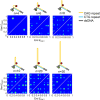Conformational and migrational dynamics of slipped-strand DNA three-way junctions containing trinucleotide repeats
- PMID: 33420051
- PMCID: PMC7794359
- DOI: 10.1038/s41467-020-20426-3
Conformational and migrational dynamics of slipped-strand DNA three-way junctions containing trinucleotide repeats
Abstract
Expansions of CAG/CTG trinucleotide repeats in DNA are the cause of at least 17 degenerative human disorders, including Huntington's Disease. Repeat instability is thought to occur via the formation of intrastrand hairpins during replication, repair, recombination, and transcription though relatively little is known about their structure and dynamics. We use single-molecule Förster resonance energy transfer to study DNA three-way junctions (3WJs) containing slip-outs composed of CAG or CTG repeats. 3WJs that only have repeats in the slip-out show two-state behavior, which we attribute to conformational flexibility at the 3WJ branchpoint. When the triplet repeats extend into the adjacent duplex, additional dynamics are observed, which we assign to interconversion of positional isomers. We propose a branchpoint migration model that involves conformational rearrangement, strand exchange, and bulge-loop movement. This migration has implications for how repeat slip-outs are processed by the cellular machinery, disease progression, and their development as drug targets.
Conflict of interest statement
The authors declare no competing interests.
Figures




Similar articles
-
Slipped-strand DNAs formed by long (CAG)*(CTG) repeats: slipped-out repeats and slip-out junctions.Nucleic Acids Res. 2002 Oct 15;30(20):4534-47. doi: 10.1093/nar/gkf572. Nucleic Acids Res. 2002. PMID: 12384601 Free PMC article.
-
Frustration Between Preferred States of Complementary Trinucleotide Repeat DNA Hairpins Anticorrelates with Expansion Disease Propensity.J Mol Biol. 2023 May 15;435(10):168086. doi: 10.1016/j.jmb.2023.168086. Epub 2023 Apr 5. J Mol Biol. 2023. PMID: 37024008 Free PMC article.
-
High-Resolution NMR Structures of Intrastrand Hairpins Formed by CTG Trinucleotide Repeats.ACS Chem Neurosci. 2024 Feb 21;15(4):868-876. doi: 10.1021/acschemneuro.3c00769. Epub 2024 Feb 6. ACS Chem Neurosci. 2024. PMID: 38319692
-
Structural and Dynamical Properties of Nucleic Acid Hairpins Implicated in Trinucleotide Repeat Expansion Diseases.Biomolecules. 2024 Oct 10;14(10):1278. doi: 10.3390/biom14101278. Biomolecules. 2024. PMID: 39456210 Free PMC article. Review.
-
Trinucleotide repeat DNA structures: dynamic mutations from dynamic DNA.Curr Opin Struct Biol. 1998 Jun;8(3):321-30. doi: 10.1016/s0959-440x(98)80065-1. Curr Opin Struct Biol. 1998. PMID: 9666328 Review.
Cited by
-
Fluctuations in Medium Viscosity May Affect the Stability of the CAG Tract in the ATXN2 Gene.Biomedicines. 2024 Oct 19;12(10):2396. doi: 10.3390/biomedicines12102396. Biomedicines. 2024. PMID: 39457708 Free PMC article.
-
Peculiarities of Scattering of Ultrashort Laser Pulses on DNA and RNA Trinucleotides.Int J Mol Sci. 2022 Dec 6;23(23):15417. doi: 10.3390/ijms232315417. Int J Mol Sci. 2022. PMID: 36499759 Free PMC article.
-
Higher-Order DNA Secondary Structures and Their Transformations: The Hidden Complexities of Tetrad and Quadruplex DNA Structures, Complexes, and Modulatory Interactions Induced by Strand Invasion Events.Biomolecules. 2024 Nov 29;14(12):1532. doi: 10.3390/biom14121532. Biomolecules. 2024. PMID: 39766239 Free PMC article.
-
Stability of the CAG Tract in the ATXN2 Gene Depends on the Localization of CAA Interruptions.Biomedicines. 2024 Jul 24;12(8):1648. doi: 10.3390/biomedicines12081648. Biomedicines. 2024. PMID: 39200113 Free PMC article.
-
A single CAA interrupt in a DNA three-way junction containing a CAG repeat hairpin results in parity-dependent trapping.Nucleic Acids Res. 2024 Aug 27;52(15):9317-9327. doi: 10.1093/nar/gkae644. Nucleic Acids Res. 2024. PMID: 39041420 Free PMC article.
References
Publication types
MeSH terms
Substances
LinkOut - more resources
Full Text Sources
Other Literature Sources

